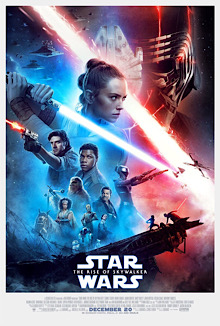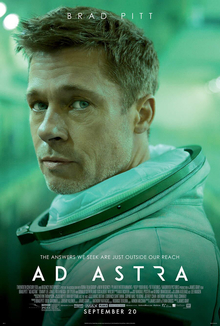From time to time, I [briefly] review movies. Not movies that are new, which the watching public may be eagerly awaiting information about, but usually movies that were new recently—and which I’ve finally gotten around to watching (most often on DVD, thanks to the local library). This time, a free month of Netflix, Prime, and a few weeks off from seminary studies helped expand the selections to some TV shows and documentaries as well. Here, in no particular order, are my thoughts.

Toy Story 4
Sequels are the worst. Unless, of course, they’re not. Toy Story 2 was arguably better than the original, and Toy Story 3 was excellent as well—if also a little dark and emotionally manipulative. Even with that track record, I didn’t hold out much hope for yet another installment. But, true to form, Woody, Buzz, & co. pulled out another improbable victory, sucking us back in and even giving new characters (Duke Kaboom!) room to come to life and shine for a moment. I guess we’re the ideal target audience for these films—Rachel & I were 11 (just like Andy) in 1995, and the movies have grown up with us, with themes (moving away from home in Toy Story 3; dealing with all our kids’ toys in Toy Story 4, etc.) that roughly parallel our life experience.
Shorter Toy Story 4: Maybe *I* am a sad, strange, little man.

The Rise of Skywalker
The one theater visit of this set of reviews, for good measure. The tradition of Star Wars on the big screen is almost as old as the tradition of Star Wars stringing along fans with a hope for an engaging storyline. If there’s a bright center to the universe of film, we’re on the planet that it’s farthest from. Even so, this final installment wasn’t unwatchably awful—some of it was actually quite good. If anything, the mistake here was J.J. Abrams trying to atone for all of the awful in the universe with a smorgasbord of fan service that doesn’t linger on anything long enough to let us savor it. There’s a nice enough bow on the ending that I think I can resist the temptation to ever spend money on this property again, no matter what Disney throws at us. Baby Yoda notwithstanding.
Shorter The Rise of Skywalker: Is it over?

Once Upon a Time in Hollywood
Any movie released back in summer that can still hold its own with nominations and wins during awards season is usually worth exploring. I got snookered into watching Pulp Fiction nearly 20 years ago, and haven’t had the stomach for Tarantino since, but I’d heard enough people talking about Once Upon a Time to give it a try. Brad Pitt is truly astonishing in this movie, the whole thing is very funny, and the revisionist history of the violent death of the golden age is a nice thought experiment, but there are points where it all still seems like an elaborate excuse to commit footage of some gratuitous carnage to the archives. Here is a good plot and great acting that almost drowns in its excesses.
Shorter Once Upon a Time in Hollywood: The least Tarantino Tarantino film, but he still can’t help himself.

Ad Astra
On the subject of Brad Pitt being truly astonishing, I submit to you this movie. It is just as understated (not a word, I’ll grant, that often gets bestowed on space dramas) as Hollywood is garish. This is science fiction at its most visceral, and the space-as-blank-canvas-for-revealing-character motif at near perfect pitch. James Gray manages to use the entire solar system as a backdrop for a story about two people, only one of whom we really see much of—and most of his lines are delivered as internal dialogue.
Shorter Ad Astra: Good science fiction always points you back toward reality.

Chernobyl
I was able to catch up on this HBO miniseries via a few Delta flights last fall, and the intensity of this story didn’t lose anything to the tiny screen—if anything the setting amplified it, leaving me at least a few times wandering around an airport gasping for breath afterward. Jared Harris, Stellan Skarsgård, and the rest of the cast suck you into 1980s Soviet groupthink and sycophancy. Gut-wrenching visual effects make you feel their human and environmental costs. A parable for our time on the dark places truth-shading and lack of curiosity will lead us.
Shorter Chernobyl: Some of the best historical storytelling I’ve seen.

The Crown—Season 3
The first two seasons of this show are so well done that I keep waiting for an inevitable letdown. The subject matter is just one bad script away from veering off into Downton Abbey banality—with the added soul-crushing value that these episodes are about real people and real politics. But Peter Morgan keeps pulling it off, bringing life and a real measure of relatability to one of the most recognizable and wealthy families on earth. Even the cast change this season wasn’t a net loss, with Tobias Menzies’ Prince Philip given many opportunities to steal the show (especially in “Moondust”).
Shorter The Crown: Fake people are people, too.

The Irishman
I’ve always liked Scorsese, but never his mob movies. This is, for film buffs everywhere, a heresy. Even so, this one rather insisted on being seen, perhaps a swan song of one of the great artists of our time. There were shortcomings—the incorporation of so many historical events in the backdrop made it feel a bit like Forrest Gump, but with a lot more blood—but most of the bold moves paid off. The 3.5 hour running time and much-vaunted de-aging technology are hardly noticeable as the story of men with too much money and too few outlets for healthy friendship and competition unrolls to its inevitably disastrous conclusions.
Shorter The Irishman: Death comes for us all, why not reflect on your life before then?

Marriage Story
Movies about divorce aren’t supposed to be cute and enjoyable, but this one had lots of quiet humor in the midst of a rolling disaster. The acting is superb top to bottom (and as a lifelong M*A*S*H fan, I’m always a sucker for Alan Alda bit parts), and the script is tight, never letting you lose sight of what a tragedy divorce and custody battles are, whatever the circumstances. The two leads are so well developed that it avoids simply retreading Kramer v. Kramer for a new generation. They’re so well developed in that their personalities hit me a little close to home. I nearly lost it when Charlie (Adam Driver’s character) breaks into “Being Alive” from Company at the end, not just because it’s inherently moving, but because belting out show tunes at karaoke seems about how I might process personal devestation.
Shorter Marriage Story: People are complex, broken, and all your feelings run together and come out at odd times. Also: this.

The Report
If you like to believe settled patterns of political life fall into neat ideological buckets, or worse, that there are more or less “good” guys and “bad” guys sorted tidily into partisan camps, don’t watch this movie. It takes an unblinking stare at the bowels of the CIA and U.S. foreign policy, and how people from other countries (even people with evil intentions and associations) are dehumanized by both parties (in this case, the Bush and Obama administrations) when it suits political needs at home. Easily the best political thriller since All the President’s Men, miraculously turning a 6,700-page government document into 2 hours of taut intrigue.
Shorter The Report: America is doomed. Also, does Adam Driver sleep?

American Factory
The flow of many familiar narratives is a journey from stasis to crisis to resolution. Sometimes, however, the bell curve inverts, and a story goes from despair to joy and back to despair. This is the case with American Factory—a multi-year tale of the shuttering of a GM plant in Dayton, Ohio, and its re-opening as an auto glass manufacturing site for a Chinese corporation. The nature of work, family, just wages, unions, safety, intercultural cooperation, and hope are all explored in depth. The filmmakers capture candid conversation so well, you almost forget that it’s a documentary.
Shorter American Factory: America is doomed

Edge of Democracy
There are few things Americans are less well-versed in than political occurrences in other countries. For that reason alone, this fine documentary chronicling the rise and fall of the Brazilian Workers Party through the impeachment of president Dilma Rousseff and speciously legal arrest and imprisonment of former president Luiz Inácio Lula da Silva is worth your time. The lessons for a politically divided U.S. (and, more to the point, its sharpening class divide) are there for those with eyes to see. The film is that much more remarkable for director Petra Costa’s ability to see her own family’s entanglement in both sides of the conflict, giving its incisive political observations a personal edge.
Shorter Edge of Democracy: America is doomed

The Ballad of Buster Scruggs
The Coen Brothers are definitely part of the “love-’em-or-hate-’em” school—you can’t ignore their work if your like movies, but they’re not to everyone’s taste. In Buster Scruggs, this is on full display, not just once, but six times. The movie is really 6 narratively disconnected shorts in a classic Western style held together by themes of death, fear, greed, and pride with trademark Coen dark humor. If you like this (which I do), it works quite well as an allegory for many aspects of American life and culture. If you don’t (which my wife does not), it really just turns the stomach to no greater purpose.
Shorter The Ballad of Buster Scruggs: America is doomed, but probably in a piecemeal, individual-demises-pooling-into-disaster sort of way.

The Two Popes
The retirement of Pope Benedict XVI and ascension of Pope Francis in 2013 remains one of the most remarkable (and controversial) papal transitions in Roman Catholic history. Brazilian director Fernando Meirelles explores this time in a fictionalized account of a visit between then-Cardinal Jorge Bergoglio (Jonathan Pryce) and Benedict (Anthony Hopkins) at the papal estate, using this conversation to explore the church’s past and its future. The result is a dialogue between the need for openness, love, and evangelism and the need for structure, stability, and courage that shows the vitality and grace of Christianity, whatever tradition you examine.
Shorter The Two Popes: Tension is actually the key to hope.

The Good Place
I can’t remember the last time I felt like binge-watching a sitcom, but I got sucked into The Good Place last month, and decided to plow right through to the series finale (on Jan. 30). This is possible—because the whole series only has about 55 episodes—and probably a fine way to watch, since the story arc follows more of the pattern of a dramatic series even as it keeps the character-driven focus of a sitcom. While there are plenty of Hollywood tropes (primarily constant sexual references) that bog things down, the end result is a series that is incredibly funny, but also heartwarming and philosophical. The creators force viewers to think about morality, death, friendship, and the purpose of existence in the face of eternal ennui. In essence, the show provides a fine exploration of the unimaginative nature of many Americans’ vaguely Christian (or vaguely Buddhist) visions of heaven and hell. Mostly, I come away thankful for Jesus (as opposed to the show’s “point system” for determining one’s afterlife) and for a robust biblical vision of the new Jerusalem as a place of creative work in fellowship with God (as opposed to a “heaven” of eternal pleasure).
Shorter The Good Place: It’s telling that the only place this sort of conversation can break out in our culture is in a sitcom.
Header image: Rock in North Chickamauga Creek, March 2016.